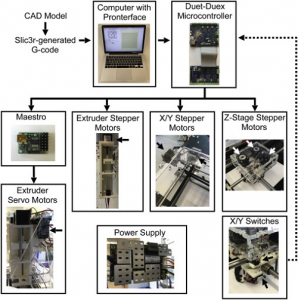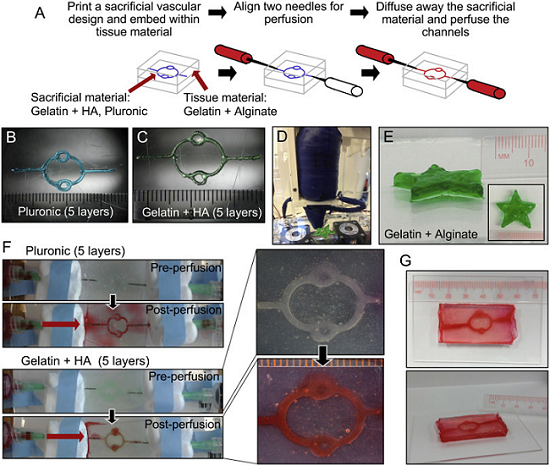Researchers Build Inexpensive Open Source Bioprinter for 3D Printing Branching, Hydrogel-Based Vascular Constructs
While 3D bioprinting is not yet able to fabricate full human organs just yet, it can be used to manufacture several different kinds of human tissue, such as heart and bile duct. One of the main barriers of forming viable tissues for clinical and scientific use is the development of vasculature for engineered tissue constructs, mainly due to generating branching channels in hydrogel constructs that can later produce vessel-like structures after being seeded with endothelial cells.
 But thanks to 3D bioprinting, it’s now possible to 3D print complex structures on multiple length scales within a single construct. This enables the generation of branching, interconnected vessel systems of small, vein-like microvessels and larger macrovessels, which couldn’t be done with former tissue engineering methods. However, the best sacrificial material for fabricating branching vascular conduits in constructs based in hydrogel has yet to be determined.
But thanks to 3D bioprinting, it’s now possible to 3D print complex structures on multiple length scales within a single construct. This enables the generation of branching, interconnected vessel systems of small, vein-like microvessels and larger macrovessels, which couldn’t be done with former tissue engineering methods. However, the best sacrificial material for fabricating branching vascular conduits in constructs based in hydrogel has yet to be determined.
A team of researchers from the University of Toronto recently published a paper, titled “Generating vascular channels within hydrogel constructs using an economical open-source 3D bioprinter and thermoreversible gels,” in the Bioprinting journal. Co-authors of the paper include Ross EB Fitzsimmons, Mark S. Aquilino, Jasmine Quigley, Oleg Chebotarev, Farhang Tarlan, and Craig A. Simmons.
The abstract reads, “The advent of 3D bioprinting offers new opportunities to create complex vascular structures within engineered tissues. However, the most suitable sacrificial material for producing branching vascular conduits within hydrogel-based constructs has not yet been resolved. Here, we assess two leading contenders, gelatin and Pluronic F-127, for a number of characteristics relevant to their use as sacrificial materials (printed filament diameter and its variability, toxicity, rheological properties, and compressive moduli). To aid in our assessment and help accelerate the adoption of 3D bioprinting by the biomedical field, we custom-built an inexpensive (< $3000 CAD) 3D bioprinter. This open-source 3D printer was designed to be fabricated in a modular manner with 3D printed/laser-cut components and off-the-shelf electronics to allow for easy assembly, iterative improvements, and customization by future adopters of the design. We found Pluronic F-127 to produce filaments with higher spatial resolution, greater uniformity, and greater elastic modulus than gelatin filaments, and with low toxicity despite being a surfactant, making it particularly suitable for engineering smaller vascular conduits. Notably, the addition of hyaluronan to gelatin increased its viscosity to achieve filament resolutions and print uniformity approaching that with Pluronic F-127. Gelatin-hyaluronan was also more resistant to plastic deformation than Pluronic F-127, and therefore may be advantageous in situations in which the sacrificial material provides structural support. We expect that this work to establish an economical 3D bioprinter and assess sacrificial materials will assist the ongoing development of vascularized tissues and will help accelerate the widespread adoption 3D bioprinting to create engineered tissues.”
Existing 3D bioprinters have different technical advantages and deposition methods, which influence their prices and available applications. Extrusion-based 3D printers are good for tissue engineering, but the cost is usually too high for the field to experience significant growth.
For this experiment, the researchers chose to create their own open source 3D bioprinter, which costs roughly $3,000 and can be used for lower resolution applications, such as 3D printing perfusable microvessels in tissue constructs.
Both the chosen method and material have to meet a certain number of requirements to successfully 3D print complex branching vessel systems within hydrogel constructs. First, sacrificial materials, which need to be non-toxic and maintain a uniform filament diameter during printing, have to be deposited in the desired vascular design during printing, then flushed away once the construct is done.
In addition, the 3D printer needs to have enough resolution to print all the channels – even those that will act as the small artery vessels of ~0.5–1 mm. It also needs to be able to deposit at least two materials, though more is better when it comes to creating heterogeneous tissues with different regions of varying cell and hydrogel composition.
The team investigated formulations of gelatin and PF127 due to their potential advantages as sacrificial materials in hydrogel-based tissue constructs. Gelatin, which has been used in several biomedical applications, is a thermoreversible (the property of certain substances to be reversed when exposed to heat) biopolymer of several hydrolyzed collagen segments, and can be 3D printed at ~37 °C, which is a temperature compatible with cells.
PF127 is a surfactant, meaning that it could have potential cytotoxic effects on embedded cells. But, it has inverse thermal gelation, which means it can be 3D printed at an ambient temperature, and then removed at ~4 °C to create void vascular channels.
According to the paper, “By using our custom-built printer in order to assess the printability of these materials and assessing mechanical properties, we aimed to establish which may be the best option for creating branching vascular channels within engineered tissues.”
The team’s modular 3D bioprinter includes extruding systems, 3D printed out of ABS on a MakerBot 3D printer, which were designed specifically to hold commercially-available, sterile 10 mL syringes, instead of custom-made reservoirs that would need to be specially made and repeatedly sterilized. An open-source Duet v0.6 controller board controls the system, and the print heads are isolated from the XYZ movements executed by the lower part of the chassis.
For testing purposes, water droplets were 3D printed in a defined pattern with each extruder system, and the average distance between the droplets’ centers in the X and Y directions were measured; then, the mean distances were compared to the pre-defined CAD model distances.
“In conclusion, we found that PF127 is generally superior to gelatin as a sacrificial material for creating vascularized tissues by merit of its filament uniformity during printing and its greater compressive modulus,” the paper concluded.
Discuss this and other 3D printing topics at 3DPrintBoard.com or share your thoughts in the Facebook comments below.
Subscribe to Our Email Newsletter
Stay up-to-date on all the latest news from the 3D printing industry and receive information and offers from third party vendors.
You May Also Like
IperionX Inks 10-Year Deal with Wisconsin Manufacturer for 80 Metric Tons of Titanium Per Year
IperionX, the Charlotte-based supplier of sustainable titanium powders used for additive manufacturing (AM) and metal injection molding (MIM), has signed a ten-year deal with United Stars, a group of industrial...
Gastronology Launches Industrial Production of 3D Printed Food for Dysphagia Patients
Food 3D printing has, in many ways, been an additive manufacturing (AM) segment looking for the right business case. While some applications are beautiful and others may or may not...
Lockheed Martin Leads $3M Investment in Q5D’s Electronics 3D Printing System
Q5D, an original equipment manufacturer (OEM) of robotic arm, hybrid additive manufacturing (AM) systems used for wire harness production, has closed a $3 million investment round. The investment arm of...
3D Printing News Briefs, April 6, 2024: Depowdering, Cybertruck Door Handles, & More
In today’s 3D Printing News Briefs, ioTech’s digital manufacturing CLAD technology is opening up opportunities for microelectronics and additive manufacturing. Hexagon and Raytheon Technologies commercially released the Simufact Additive Process...



































